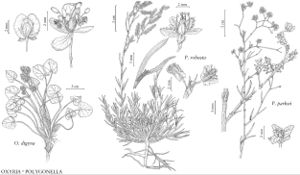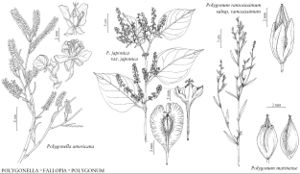Polygonella
Fl. Bor.-Amer. 2: 240. 1803.
Shrubs, subshrubs, or herbs, perennial or annual, synoecious, dioecious, gynodioecious, or gynomonoecious; taproots woody. Stems erect, decumbent, or prostrate, glabrous or scabrous. Branches adnate to stems, appearing to arise internodally. Leaves deciduous or, rarely, with leaves persisting more than 1 year, sometimes fugacious, cauline, alternate; ocrea usually persistent, sometimes disintegrating with age and deciduous distally, chartaceous or coriaceous; petiole apparently absent, articulate basally; blade filiform to broadly obovate, margins entire. Inflorescences terminal, racemelike, pedunculate. Pedicels present. Flowers bisexual, or some or all functionally unisexual, 1 per ocreate fascicle, base stipelike; perianth nonaccrescent, white, pink, red, greenish, or yellowish, campanulate, glabrous; tepals 5, distinct, petaloid, dimorphic, in 2 whorls with 2 outer and 3 inner or 2 outer and 2 inner plus 1 transitional; stamens 8, in 2 series with 5 outer and 3 inner; filaments distinct, free, dilated proximally, dimorphic, inner 3 dilated more abruptly than outer 5, with toothed or horned shoulders, or monomorphic (in P. fimbriata and P. robusta), glabrous (pubescent basally in P. basiramia); anthers white, yellow, orange, pink, or dark red, elliptic to ovate or round; styles (2–) 3, erect, distinct; stigmas (2–) 3, capitate. Achenes included or exserted, yellowbrown, brown, or reddish-brown, wingless or narrowly winged, (2–) 3 (–4) -gonous, glabrous. Seeds: embryo straight or slightly curved. x = 11.
Distribution
e, sc United States
Discussion
Species 11 (11 in flora).
Polygonella is distinct from other genera of Polygonaceae in having branches adnate to the stem and thus appearing to arise internodally. Palynological, anatomical, and morphological evidence suggests Polygonella is closely related to Polygonum sect. Duravia (L.-P. Ronse Decraene et al. 2004; Hong S. P. et al. 1998; P. O. Lewis 1991).
Within-population allozyme diversity is lower in the two most widespread species of the genus as compared to their narrowly endemic congeners (P. O. Lewis and D. J. Crawford 1995). High levels of selfing or depletion of diversity due to Pleistocene glaciation have been suggested as possible explanations for the lower allozyme diversity within populations of Polygonella americana and P. articulata.
Selected References
Lower Taxa
Key
| 1 | Margins of inner tepal deeply fringed; filaments of stamens monomorphic | > 2 |
| 1 | Margins of inner tepal entire to erose; filaments of stamens dimorphic | > 3 |
| 2 | Margins of leaf blade not hyaline; stems scabrous or, sometimes, glabrous proximally | Polygonella fimbriata |
| 2 | Margins of leaf blade hyaline; stems glabrous or sparingly scabrous on angles distally | Polygonella robusta |
| 3 | Ocreae margins ciliate | > 4 |
| 3 | Ocreae margins not ciliate | > 6 |
| 4 | Ocreolae not encircling rachis of raceme, their sides and bases adnate to rachis; inflorescences 2-6(-8) mm; outer tepals 0.5-0.9 mm in anthesis | Polygonella parksii |
| 4 | Ocreolae encircling rachis of raceme, only their bases adnate to rachis; inflorescences 10-45 mm; outer tepals 0.7-1.5 mm in anthesis | > 5 |
| 5 | Stems branched at or below ground level | Polygonella basiramia |
| 5 | Stems simple, sometimes branched distally, if present, well above ground | Polygonella ciliata |
| 6 | Leaf blades (3-)9-30 mm wide, oblanceolate to obovate or broadly spatulate | Polygonella macrophylla |
| 6 | Leaf blades 0.3-6(-8) mm wide, filiform to broadly spatulate | > 7 |
| 7 | Styles and stigmas 0.4-1 mm in anthesis; plants perennial | > 8 |
| 7 | Styles and stigmas ca. 0.1 mm or less in anthesis; plants annual or perennial | > 9 |
| 8 | Stems erect; outer tepals sharply reflexed early in anthesis and in fruit | Polygonella americana |
| 8 | Stems prostrate; outer tepals loosely appressed in anthesis, sometimes spreading in fruit | Polygonella myriophylla |
| 9 | Plants perennial; margins of leaf blade hyaline at least along distal 1/ 2; outer tepals usually reflexed in fruit | Polygonella polygama |
| 9 | Plants annual; margins of leaf blade not hyaline; outer tepals loosely appressed to spreading in fruit | > 10 |
| 10 | Pedicels 0.9-3 mm, longer than subtending ocreolae; leaf blades 0.4-1.2 mm wide | Polygonella articulata |
| 10 | Pedicles 0.1-0.3 mm, as long as subtending ocreolae; leaf blades 0.8-5(-8) mm wide | Polygonella gracilis |
"/2" is not declared as a valid unit of measurement for this property.

